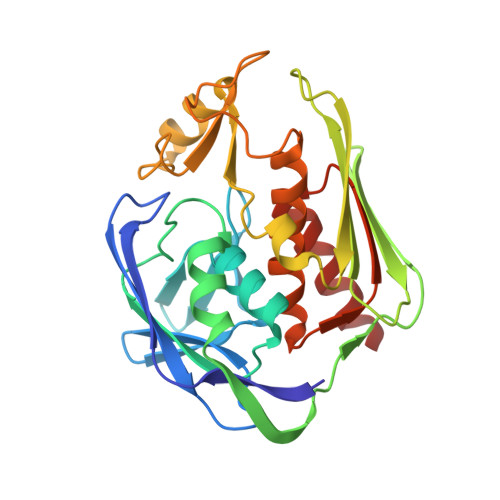UDP-3-O-((R)-3-hydroxymyristoyl)-N-acetylglucosamine Deacetylase Functions through a General Acid-Base Catalyst Pair Mechanism
Hernick, M., Gennadios, H.A., Whittington, D.A., Rusche, K.M., Christianson, D.W., Fierke, C.A.(2005) J Biol Chem 280: 16969-16978
- PubMed: 15705580
- DOI: https://doi.org/10.1074/jbc.M413560200
- Primary Citation of Related Structures:
1YH8, 1YHC - PubMed Abstract:
UDP-3-O-((R)-3-hydroxymyristoyl)-N-acetylglucosamine deacetylase (LpxC) is a zinc-dependent enzyme that catalyzes the deacetylation of UDP-3-O-((R)-3-hydroxymyristoyl)-N-acetylglucosamine to form UDP-3-O-(R-hydroxymyristoyl)glucosamine and acetate. The structural similarity of the active site of LpxC to metalloproteases led to the proposal that LpxC functions via a metalloprotease-like mechanism. The pH dependence of k(cat)/Km catalyzed by Escherichia coli and Aquifex aeolicus LpxC displayed a bell-shaped curve (EcLpxC yields apparent pKa values of 6.4+/-0.1 and 9.1+/-0.1), demonstrating that at least two ionizations are important for maximal activity. Metal substitution and mutagenesis experiments suggest that the basic limb of the pH profile is because of deprotonation of a zinc-coordinated group such as the zinc-water molecule, whereas the acidic limb of the pH profile is caused by protonation of either Glu78 or His265. Furthermore, the magnitude of the activity decreases and synergy observed for the active site mutants suggest that Glu78 and His265 act as a general acid-base catalyst pair. Crystal structures of LpxC complexed with cacodylate or palmitate demonstrate that both Glu78 and His265 hydrogen-bond with the same oxygen atom of the tetrahedral intermediate and the product carboxylate. These structural features suggest that LpxC catalyzes deacetylation by using Glu78 and His265 as a general acid-base pair and the zinc-bound water as a nucleophile.
Organizational Affiliation:
Department of Chemistry, University of Michigan, Ann Arbor, Michigan 48109, USA.

















